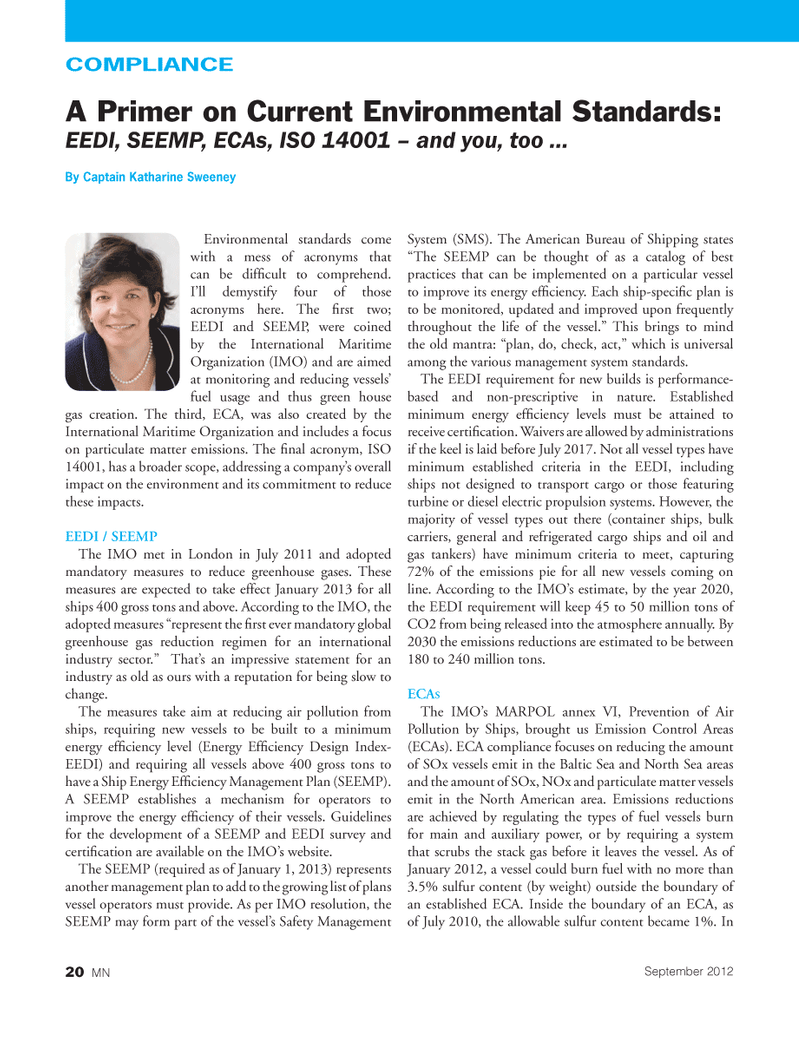
Page 20: of Marine News Magazine (September 2012)
Environment: Stewardship & Compliance
Read this page in Pdf, Flash or Html5 edition of September 2012 Marine News Magazine
Environmental standards come with a mess of acronyms that can be difÞ cult to comprehend. IÕll demystify four of those acronyms here. The Þ rst two; EEDI and SEEMP, were coined by the International Maritime Organization (IMO) and are aimed at monitoring and reducing vesselsÕ fuel usage and thus green house gas creation. The third, ECA, was also created by the International Maritime Organization and includes a focus on particulate matter emissions. The Þ nal acronym, ISO 14001, has a broader scope, addressing a companyÕs overall impact on the environment and its commitment to reduce these impacts. EEDI / SEEMPThe IMO met in London in July 2011 and adopted mandatory measures to reduce greenhouse gases. These measures are expected to take effect January 2013 for all ships 400 gross tons and above. According to the IMO, the adopted measures Òrepresent the Þ rst ever mandatory global greenhouse gas reduction regimen for an international industry sector.Ó ThatÕs an impressive statement for an industry as old as ours with a reputation for being slow to change. The measures take aim at reducing air pollution from ships, requiring new vessels to be built to a minimum energy efÞ ciency level (Energy EfÞ ciency Design Index- EEDI) and requiring all vessels above 400 gross tons to have a Ship Energy EfÞ ciency Management Plan (SEEMP). A SEEMP establishes a mechanism for operators to improve the energy efÞ ciency of their vessels. Guidelines for the development of a SEEMP and EEDI survey and certiÞ cation are available on the IMOÕs website. The SEEMP (required as of January 1, 2013) represents another management plan to add to the growing list of plans vessel operators must provide. As per IMO resolution, the SEEMP may form part of the vesselÕs Safety Management System (SMS). The American Bureau of Shipping states ÒThe SEEMP can be thought of as a catalog of best practices that can be implemented on a particular vessel to improve its energy efÞ ciency. Each ship-speciÞ c plan is to be monitored, updated and improved upon frequently throughout the life of the vessel.Ó This brings to mind the old mantra: Òplan, do, check, act,Ó which is universal among the various management system standards. The EEDI requirement for new builds is performance- based and non-prescriptive in nature. Established minimum energy efÞ ciency levels must be attained to receive certiÞ cation. Waivers are allowed by administrations if the keel is laid before July 2017. Not all vessel types have minimum established criteria in the EEDI, including ships not designed to transport cargo or those featuring turbine or diesel electric propulsion systems. However, the majority of vessel types out there (container ships, bulk carriers, general and refrigerated cargo ships and oil and gas tankers) have minimum criteria to meet, capturing 72% of the emissions pie for all new vessels coming on line. According to the IMOÕs estimate, by the year 2020, the EEDI requirement will keep 45 to 50 million tons of CO2 from being released into the atmosphere annually. By 2030 the emissions reductions are estimated to be between 180 to 240 million tons. ECASThe IMOÕs MARPOL annex VI, Prevention of Air Pollution by Ships, brought us Emission Control Areas (ECAs). ECA compliance focuses on reducing the amount of SOx vessels emit in the Baltic Sea and North Sea areas and the amount of SOx, NOx and particulate matter vessels emit in the North American area. Emissions reductions are achieved by regulating the types of fuel vessels burn for main and auxiliary power, or by requiring a system that scrubs the stack gas before it leaves the vessel. As of January 2012, a vessel could burn fuel with no more than 3.5% sulfur content (by weight) outside the boundary of an established ECA. Inside the boundary of an ECA, as of July 2010, the allowable sulfur content became 1%. In COMPLIANCEA Primer on Current Environmental Standards: EEDI, SEEMP, ECAs, ISO 14001 ? and you, too ? By Captain Katharine Sweeney20 MNSeptember 2012MNSept2012 Layout 18-31.indd 20MNSept2012 Layout 18-31.indd 208/31/2012 12:03:08 PM8/31/2012 12:03:08 PM

 19
19

 21
21
